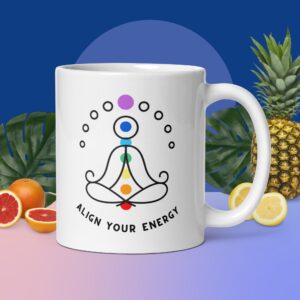Table of Contents
- What is a mantra and its purpose
- Why do we focus on I am Meditation Mantra
- The power of I Am Mantra : The psychology and neuroscience behind I Am mantra
- How to Create Your Own I Am Mantra
- How to Apply I Am Mantras in Everyday Life
- 8 Examples of I Am mantras to make your life better
- Benefits of I am Mantra and Impact to Mental Health and Well-being
- What is the I am mantra in Kundalini Yoga?
- Misconceptions and Challenges about I am Mantra
- Final Thoughts
We’re all guilty of it — talking ourselves down, drowning in self-doubt, or entertaining negative self-talk. It’s easy to forget the power our own words have in shaping our reality. It’s time to rewrite that narrative with a potent tool: the “I Am” mantra. This two-letter phrase may seem simple, yet it packs a transformative punch.
Now, I’m going to share how “I Am” mantras can become your secret weapon for self-improvement and personal development. It’s not some mystical mumbo-jumbo; it’s a practice steeped in psychology and backed by scientific research. Whether you’re trying to build confidence, overcome anxiety, or simply instill more positivity in your life, “I Am” mantras can be tailored to your needs.
You might be skeptical. Can a two-word phrase truly spark significant change in your life? Stick around as we delve into the I Am mantra’s power, how you can create your personalized mantras, and ways to incorporate them into your everyday life.
I promise you’ll come out on the other side with a fresh perspective and an appetite for positive self-affirmation. Consider this article your guide to unlocking the full potential of “I Am”. The journey towards a better self starts here.
What is a mantra and its purpose
A mantra – the word itself evokes a sense of tranquility, doesn’t it? But let’s step back for a moment. What exactly is a mantra? Originating from ancient Sanskrit, ‘mantra’ literally translates to ‘instrument of thought’.
It’s a powerful sound or vibration that you can use to enter a deep state of meditation. They’re not just for the yoga enthusiasts or spiritual gurus among us; anyone can harness their potential.
The purpose of a mantra is as diverse as the people who use them. At its core, a mantra helps focus the mind, grounding us in the present and sidestepping the whirlwind of thoughts that so often preoccupy our minds. Think of it as your personal catchphrase – something you repeat to yourself to encourage positivity, motivation, and tranquility.
Whether it’s building self-confidence, cultivating love, or encouraging peace and happiness, mantras can be tailored to whatever you’re aiming for in life.
Simply put, they’re a mental tool to guide and uplift your spirit. Now, let’s delve into why the “I Am” mantra holds a special place in this practice.
Why do we focus on I am Meditation Mantra

So, we’ve got the basics of what a mantra is. Now, let’s zero in on the I Am mantra and its particular power. These mantras are unique because they start with the words “I Am,” followed by a positive affirmation. The key here is that the affirmation is stated in the present tense, not the future. Instead of saying “I will be,” you say “I am,” and therein lies the magic.
I Am mantras function as an assertive self-declaration, a way to rewrite our internal narrative. You see, our subconscious mind doesn’t discern between what’s real and what’s not; it takes in everything we say about ourselves as fact.
When you affirm “I am confident,” “I am strong,” “I am worthy,” you’re instructing your mind to view these qualities as your present reality. It’s like pressing ‘update’ on the software of your mind, except the code you’re altering is your self-perception and self-belief.
Harnessing the power of I Am mantras isn’t just a mental game. It’s a potent tool to manifest real change in our lives, shaping how we see ourselves and, in turn, how we behave and interact with the world.
Think of these mantras as the steering wheel of your mind’s vehicle – they have the power to direct your journey, leading you towards your desired destination. Let’s dig deeper into how you can create and use your own I Am mantras in your quest for personal transformation.
The power of I Am Mantra : The psychology and neuroscience behind I Am mantra

Let’s take a dive into the science that underpins these powerful I Am mantras. It’s not all mystical and metaphysical; there’s some solid psychology and neuroscience backing the effectiveness of positive affirmations.
When we repeat positive affirmations like “I Am,” we’re tapping into an interesting aspect of our brain’s functionality – neuroplasticity. This is our brain’s ability to reorganize itself by forming new neural connections throughout life. It means our minds aren’t set in stone; they’re adaptable and can be rewired.
Here’s where the I Am mantra comes in. When you regularly affirm positive statements about yourself, you’re effectively training your brain to perceive these as your reality. Each repetition strengthens these neural pathways, making it easier for your brain to access these positive self-beliefs. It’s like carving a path through a forest; the more frequently you tread that path, the more defined and familiar it becomes.
Moreover, these positive affirmations can stimulate the reward centers in our brain, releasing chemicals that make us feel good – a mini-brain celebration, if you will. This creates a positive feedback loop; we feel good when we repeat these affirmations, which makes us want to repeat them more.
In terms of psychology, “I Am” mantras are akin to cognitive behavioral techniques. They help challenge and combat negative self-beliefs and thought patterns, replacing them with healthier, positive ones. It’s a proactive way to combat the sometimes self-defeating narratives we play in our heads. In essence, “I Am” mantras help us become our own cheerleaders.
So you see, it’s not just a feel-good phrase. The I Am mantra can be a powerful ally in transforming our thought patterns and fostering a positive self-image. It’s not magic – it’s a blend of neurology, psychology, and a sprinkle of self-belief. Now, let’s get down to creating your own personal “I Am” mantra.
Key takeaways of power of the I am mantra:
- Harnessing Neuroplasticity: “I Am” mantras tap into the brain’s neuroplasticity, helping to form positive neural connections through repetition of affirmations.
- Positive Feedback Loop: The repetition of these mantras stimulates the brain’s reward centers, creating a cycle of positive.
- Transforming Self-perception: Much like cognitive behavioral techniques, these mantras challenge negative self-beliefs and promote healthier thought patterns.
How to Create Your Own I Am Mantra

Ready to embark on the empowering journey of creating your own “I Am” mantra? It’s not as daunting as it may seem. These potent statements are meant to be personal, reflecting your aspirations and the positive traits you want to nurture within yourself.
Here, I’ll guide you through a few simple steps to crafting your very own I Am meditation mantra. This is your opportunity to influence your subconscious mind and reprogram it with positive, resilience, and self-belief.
So, let’s dive right in:
Identify Your Needs and Goals: Begin by reflecting on what you’d like to improve or manifest in your life. Are you seeking more confidence? Do you want to cultivate a more positive mindset? Or maybe you want to instill a sense of inner peace? Your mantra should align with your personal goals.
Keep It Positive and Present: Remember, the mantra should always be in the present tense and carry a positive message. This reinforces the concept that your desired state is not a future aspiration, but a present reality.
Keep It Concise: Your I Am mantra doesn’t need to be a lengthy sentence. Keeping it short and sweet makes it easier to remember and repeat. Aim for powerful, impact words that resonate with you.
Make It Personal: It’s essential to create a mantra that feels true to you. Don’t just copy someone else’s mantra. Your mantra should touch upon what you truly desire and resonate with your personal journey.
Repeat It Daily: The key to making your “I Am” mantra work for you is repetition. Say it to yourself when you wake up, during your lunch break, before going to bed, or anytime in between. The more often you affirm it, the deeper it embeds into your subconscious mind.
Believe in It: This is perhaps the most crucial part. You need to believe in your mantra and the positive change it brings. Trust in the process and the power of your own words.
Creating your own I Am mantra is an exercise in self-awareness, positivity, and personal growth. It’s your opportunity to shape your self-perception and direct your journey towards personal transformation. And remember, there’s no ‘wrong’ mantra; if it rings true to you and uplifts your spirit, it’s perfect.
How to Apply I Am Mantras in Everyday Life

Now that you’ve crafted your “I Am” mantra, it’s time to integrate it into your daily routine. You’ve got this personalized self-affirmation, a potent tool for self-improvement, and it’s all about putting it into action.
Let’s discuss how to weave your mantra into the fabric of your everyday life.
Believe me when I say, this isn’t a cumbersome task. Mantras aren’t demanding; they’re flexible, ready to fit seamlessly into your schedule.
Their purpose is to uplift your spirit, not add to your to-do list. So, let’s explore some strategies for effortlessly integrating your I Am meditation mantras into your day:
Morning Routine: Start your day on a positive note by repeating your mantra as soon as you wake up. Make it part of your morning routine, like brushing your teeth or sipping that first cup of coffee.
Mindful Moments: Incorporate your mantra into your mindfulness or meditation practices. This amplifies the focus on the present moment and deepens your connection with the mantra.
Mirror Mantra: Say your mantra out loud to yourself in the mirror. This practice can strengthen your connection with your reflection, bolstering self-belief and self-love.
Journalling: Write down your mantra in a journal. The act of writing it down can reinforce its message and make it more tangible. You could even doodle or color around it, making the process more engaging and creative.
Digital Reminders: Set periodic reminders on your phone or computer to recite your mantra. In our digitally connected world, this can be a simple and effective way to keep your mantra top-of-mind.
Nighttime Reflection: End your day on a positive note by reciting your mantra before bed. This can help calm your mind and in still positive as you drift off to sleep.
Listen to I am Mantra Meditation Video
Remember, the goal here is not to cram your day with forced repetitions of your mantra, but to make it a natural part of your life. It’s a gentle reminder to yourself of who you are and who you aspire to be.
By embedding your I Am meditation mantra into your daily routine, you’re making a consistent commitment to positive, self-growth, and transformation. Now, how’s that for a daily habit?
8 Examples of I Am mantras to make your life better

Perfect! Now that you’re well-versed in the art of creating your own I Am mantra and weaving it into your everyday routine, I believe it could be helpful to provide some examples. Remember, these mantras are as diverse as the people who use them.
They serve as a mirror reflecting individual aspirations and the traits we’re looking to cultivate in our lives. While your mantra should always be personal and resonant to you, these examples might spark some inspiration:
“I Am Confident”: A classic mantra for those looking to boost their self-confidence. It’s a powerful reminder of your inherent strength and capabilities.
“I Am Enough”: This mantra serves as an affirmation of self-worth, reminding you that you are valuable just as you are, without needing to prove anything to anyone.
“I Am Grateful”: A mantra for cultivating an attitude of gratitude. It’s a gentle prompt to appreciate the good in your life.
“I Am Radiating Positive”: Ideal for those seeking to foster a more positive mindset. This mantra encourages you to exude positive energy into your surroundings.
“I Am At Peace”: This is a soothing mantra that promotes inner peace and tranquility, helping you find calm amid the chaos.
“I Am Resilient”: A mantra that acknowledges your ability to bounce back from adversity. It reinforces your inherent toughness and adaptability.
“I Am Open to New Possibilities”: This mantra is for those eager to embrace change and new opportunities. It signifies a readiness to step out of your comfort zone and grow.
“I Am Love”: A simple, yet profound, mantra that reinforces your capacity to give and receive love.
Remember, your mantra is your personal self-affirmation. These examples are just the tip of the iceberg. The beauty of I Am mantras is that they can be tailored to your individual needs and aspirations.
So, feel free to create one that truly resonates with your journey and aspirations. Happy mantra-making!
Benefits of I am Mantra and Impact to Mental Health and Well-being

Absolutely! I Am mantras, while simple in form, hold immense potential when it comes to mental health and overall well-being. These potent declarations have a profound effect on our minds, emotions, and even our physical selves, reiterating the inseparable connection between our thoughts and our realities.
Let’s unravel the benefits that these powerful affirmations bring to our lives:
Enhanced Self-Belief: By repeating positive affirmations like “I Am Confident” or “I Am Capable,” you gradually strengthen your self-belief. It’s like working out your confidence muscle, making it stronger with each repetition. Over time, you’ll find it easier to tackle challenges and step outside your comfort zone.
Boosted Positivity: Positive “I Am” mantras like “I Am Radiating Positive” or “I Am Grateful” can shift your focus towards the brighter side of life. They help cultivate a more optimistic mindset, fostering happiness and contentment.
Reduced Stress and Anxiety: Mantras such as “I Am At Peace” or “I Am Calm” can be an effective tool for managing stress and anxiety. They serve as calming anchors, helping you navigate turbulent emotional waters with greater ease and stability.
Greater Resilience: By repeating affirmations like “I Am Resilient” or “I Am Strong,” you fortify your ability to bounce back from adversities. These mantras reinforce your inherent strength and resilience, empowering you to weather life’s storms.
Improved Mental Health: Regular use of “I Am” mantras can improve mental health by reducing negative self-talk and enhancing self-compassion. They serve as positive reinforcements that bolster self-esteem and promote a healthier self-image.
Holistic Well-being: When used consistently, “I Am” mantras can contribute to overall well-being. They not only boost mental health but also influence physical health by reducing stress, which is a known risk factor for many physical health problems.
Remember, the power of the I Am meditation mantra lies in its repetition and your belief in it. By consciously choosing the words that follow “I Am,” you are programming your subconscious mind, shaping your self-perception, and directing your journey towards better mental health and overall well-being. So, “I Am” ready to embrace the power of mantras – are you?
What is the I am mantra in Kundalini Yoga?
Let’s delve into a slightly different realm where the I Am mantra is also employed, the Kundalini Yoga tradition. In this ancient yogic practice, mantras are regarded as powerful tools for transformation and consciousness-raising. Among the multitude of mantras used, the “I Am” mantra holds a distinct place.
In Kundalini Yoga, the I Am mantra is often expanded to “I Am That I Am.” This mantra, also known as Sat Nam in the original Gurmukhi language, carries a profound spiritual meaning. It’s not just about self-affirmation; it’s an acknowledgement of one’s true, divine nature.
When Kundalini yogis say “I Am That I Am”, they are asserting their existence in the most profound sense. It’s a declaration that they exist as individual beings (“I Am”), but they’re also part of the infinite, divine consciousness (“That I Am”).
It’s an affirmation of unity with the cosmos, a recognition that the individual self and the universal self are one and the same. It’s a way of acknowledging and connecting with the true, unchanging essence that lies beneath our ever-changing worldly identities.
In Kundalini Yoga, the “I Am That I Am” mantra is often used in meditation, where it’s chanted or silently repeated to attune the practitioner’s consciousness to this fundamental truth of their existence. It’s believed that this mantra can lead to profound spiritual insights and experiences, fostering a sense of peace, wholeness, and unity with the divine.
So, while the I Am mantras we’ve discussed so far are about affirming personal qualities and aspirations, the “I Am” mantra in Kundalini Yoga has a more spiritual focus, reminding us of our divine essence and unity with the cosmos. Whether used for personal growth or spiritual enlightenment, the “I Am” mantra holds immense potential to transform and uplift.
Misconceptions and Challenges about I am Mantra
One misconception about “I Am” mantras is that they act as magic words, manifesting change instantly, but they’re not an immediate or supernatural fix. The mantras are tools for reshaping mindset over time, not instant generators of wealth or success.
Challenges often include skepticism and combating negative thought patterns. It might seem difficult to believe that simple affirmations can transform your life, and it might feel uncomfortable to use a positive mantra that contradicts your current self-perception. However, with consistency and belief, these barriers can be overcome, leading to meaningful change.
In summary, “I Am” mantras aren’t magic, and they do require effort and patience, but their potential for personal transformation makes them an invaluable tool for growth.
Final Thoughts
In the journey of self-discovery and growth, “I Am” mantras serve as powerful guiding lights. Whether it’s fostering positivity, building self-confidence, or fostering a sense of inner peace, these potent affirmations have the potential to reshape our realities.
As we’ve seen, their application extends from personal development to spiritual practices like Kundalini Yoga, signifying our unity with the cosmos. While some misconceptions and challenges exist, with patience, consistency, and belief, “I Am” mantras can prove to be transformative tools for mental health and overall well-being.
So, as you embark on your own journey of self-transformation, remember the power of “I Am” – a simple affirmation that can open the door to a world of positive change.


















